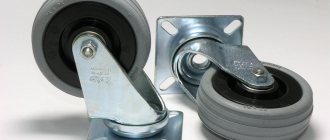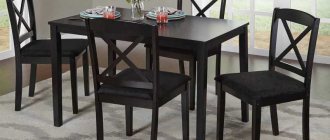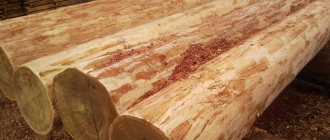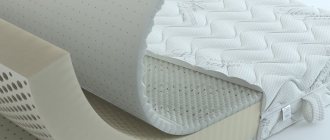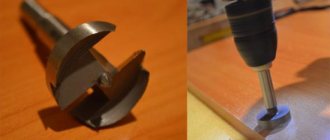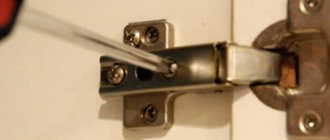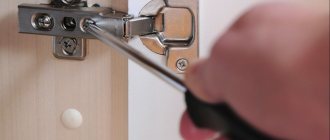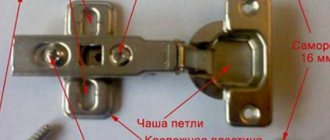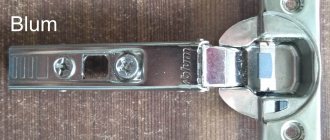Features of fittings
The only purpose of any door closer is to automatically close the doors. It is easy enough to push the sash equipped with it, and it will close itself. In this case, only hinges equipped with a shock absorber operate smoothly. Despite the differences, the design of almost all hinges for frame furniture is the same. The fittings consist of the following elements:
- an installation platform with mounting holes, which is located on the wall of the housing;
- counter platform - a cup installed on the facade from the inside (recessed or overhead);
- a hinge connecting parts of the device;
- door closer (optional);
- shock absorber (optional);
- adjusting elements: strips, pins, fixed with special screws.
The operating principle of this fitting is quite simple, so furniture hinges with a spring closer are not uncommon. In terms of reliability, aesthetics and ease of use, different models differ significantly. Using high-quality hinges with a closer provides the following advantages:
- semi-automatic, pleasant-feeling door closing;
- absence of irritating pops and blows;
- increasing the service life of the facade and body;
- simplified adjustment of the door position, adjustment of the speed of operation of the closer;
- significant service life of the loop;
- an opportunity to demonstrate the status and taste of the owner of the house.
Shock absorbers can be built-in or overhead, which are installed separately. The principle of their operation is identical to the operation of an automobile unit. One of the two communicating chambers is filled with oil or gas. When the door is opened (closed), the working medium in the closer flows through a narrow channel into the second chamber. Since the speed of its movement is limited, the door cannot slam shut sharply.
Rules for selecting mortise handles for furniture, installation nuances
Manufacturing materials
The main difference between prestigious models and economy class models, in addition to the presence of a shock absorber, is the quality of the metal, coating, and assembly. Moreover, expensive furniture hinges equipped with a closer cannot be light in weight. That is, the wall thickness of the parts is no less important than the steel grade. The metal itself, as a rule, is hardened and does not contain impurities that weaken it, because the weight of the facades is often serious.
Any steel fittings for furniture that bear a load are coated with an anti-corrosion decorative layer. The most popular materials for hinges: bronze, brass, chrome, nickel, zinc, polymers, enamels. High-quality processed metals are inert to the effects of water, oxygen, and household chemicals.
Plugs that cover technological holes and heads of screws or screws prevent their contamination. Gaskets made of rubber, silicone or plastic prevent friction of contacting surfaces.
Scope of application
The design of almost any item, including lids or doors, also contains hinges. The shock absorber and door closer in this device are not mandatory, but desirable elements, although they are often used separately:
- In wardrobes where hinges are not needed, but a closer is useful.
- In shelves and drawers that open upward, where the closers (aka shock absorbers) are usually more massive, and the hinges are standard.
- In display cases and other glass furniture, where recessed hinges are not used.
You can often find interior items with doors made of glass, which is enclosed in a wooden or metal frame. Such a frame, especially one made of wood, is quite suitable for cutting the installation cup of the hinge into it.
Most other products need hinges with a closing device, for example, children's wardrobes or desks, the doors of which fall off due to careless use. Also included in this category are office and commercial furniture and kitchen sets.
Types of furniture fronts for cabinets, popular materials
Furniture hinges with a closer: from simple to complex
Developers of furniture fittings, following market demands, are improving the design of furniture hinges in several directions. Given the wide range of materials from which furniture is made, the variety of shapes and functionality of modern cabinets, various hinge modifications are necessary. Now there are hundreds of them. Overhead, inset and semi-overhead hinges differ in the material of the facade for which they are intended and in the load they can withstand. In addition, there is a wide variety of corner hinges to suit a wide range of cabinet door opening angles. Reliability is of no small importance - how many opening cycles the hinge is designed for, how easy it is to install. Special attention should be paid to noiselessness. If we talk about the type of design, the main segment of the market has been captured by four-hinged hinges, significantly displacing card and single-hinged hinges.
#TOVAR_97271#
Such hinges not only provide free movement, they also secure the cabinet door in its extreme positions. Until recently, various dampers and shock absorbers were widely used to soften the impact. However, designers were constantly looking for a more effective solution. And this solution was hinges with a built-in shock absorber.
A damping system built into the hinge was developed that allowed the hinge to self-closing from an angle of 35°. Then a hinge appeared on the market with a shock absorber built into its cup. The developers were faced with the task of placing the most functional system in a relatively small volume of the hinge cup.
However, when using small and relatively light doors, the shock-absorbing device may not work. The Austrian company Grass has developed hinges with a shock absorber integrated into the hinge arm. In such hinges it is possible to adjust the shock absorber forces. They ensure quiet, smooth and uniform closing of the facade.
Currently, the range of hinges with a built-in closer is so wide that the manufacturer will find a suitable hinge for almost any design: for standard and corner facades with a thickness of 14 to 32 mm, for facades made of mirror or glass, aluminum frames.
For example, the MIRRO hinge from Grass with a built-in shock absorber can be attached to a glass façade without drilling. And the TIOMOS M0 hinge can be used on facades made of aluminum, wood or artificial stone with a thickness of only 6–10 mm.
See also: Hinges for glass doors Card hinges Furniture corner hinges Furniture mortise hinges Furniture hinges 90 degrees
Tips for choosing
The brand and country of origin testify to the quality of furniture hinges with closers in the same way as when choosing any other product. When purchasing, it is advisable to pay attention to the nuances that are noticeable to the naked eye:
- weight of hinges with closer;
- smoothness and clarity of movement of moving parts;
- absence of play in the operation of the hinge itself, as well as the closer;
- no chips, cracks, scratches;
- evenness, smoothness of the coating;
- Aesthetic, reliable packaging.
It will be useful to study the documents: instructions for the hinges, passports, warranty cards. Solid hieroglyphs probably won’t say anything good. In addition, a manufacturer who cares about its reputation will not hide the true place of manufacture of its product. Nevertheless, there are products whose passport does not indicate either the city or the plant.
Hinges, hinges, closers, shock absorbers without a factory mark, engraving or at least a sticker do not deserve much trust.
Perhaps one of the most serious indicators is the cost of hinges with a closer. A high-quality German item, for example, cannot cost the same as Chinese consumer goods. Although decent products from the latter country are no longer uncommon. The following manufacturers are popular:
- Boyard (Russia) has been making hinges with closers and other furniture fittings for decades. The products combine accessibility, acceptable quality, and a wide range.
- Blum (Russia) is a company that produces technologically advanced furniture fittings. Their hinges are designed so that adjustment is possible in three planes, and installation is simplified by a special mounting strip.
- GTV (Poland) - durable fittings for furniture, the class of which is above average, works smoothly and clearly, is easy to install and configure.
- Hettich (Germany) - produces models of hinges from economy class to luxury, including options with a closer. The products are distinguished by the quality of metals and assembly, ease of use, impeccable appearance, and durability.
Advantages of pine furniture board, scope of its application
The quality of the hinges is clearly indicated by the warranty period and the specified resource, that is, the number of opening and closing processes. According to Russian GOSTs, 20,000 cycles are considered acceptable; prestigious models can withstand up to 200 thousand.
Bloom
Boyard
GTV
Hettich
Insertion of overhead loops
Tools needed
Before installing kitchen hinges with a closer, you should properly prepare your workplace. Such fittings require insertion, so you will need the following tools:
- Ruler and pencil.
- Drill with a cutter of the required diameter.
- Screwdriver and set of screws.
- Building level.
With such a modest set of tools, hinges with a closer are installed.
Preparing for installation
The first step is to make the correct markings for the loops. In order to do it correctly, you must follow the following rules:
- The hinges should be no more than two centimeters from the edge of the door.
- The distance from the top and bottom edges to the outer loops is no more than 120 millimeters.
- If there are more than two loops, the middle ones are located strictly in the middle between the neighboring ones.
- There should be no shelves or other obstacles in the places where hinges are marked and future installed.
In accordance with the specified conditions, attach all the loops with closers to the surface, then circle. Don't forget to double-check all distances after marking.
Installation of door hinges with a closer
Let's start the installation
Each furniture hinge with a closer is installed according to the instructions indicated:
- Place the cutter on the drill, then place it at the position marked with a pencil.
- Make a hole for the exact size of the installed fittings with a closer.
- Install the loop into the socket you made, making sure it is firmly secured in it.
- Drill holes for the screws using a drill (you must remove the cutter).
- Secure the loop in the socket using screws, making sure it is in the correct position.
These steps must be repeated with all hinges that you plan to install. After following the instructions, the installed furniture fittings are ready for use.
Nuances of installation and adjustment
The dimensions of the installation cup are, as a rule, standard; almost all factory facades are produced with a recess for it. If it is missing, installation of loops becomes somewhat more complicated. To make a recess, you need a cutter of a suitable size and skills to work with it. However, you can practice on any piece of wood. In addition to the cutter you will need:
- drill with various drill bits;
- screwdriver, screwdriver;
- square, pencil;
- tape measure, chisel, hammer;
- building level.
Furniture is often installed unevenly due to the curvature of walls and floors. Adjusting the position of the facades will eliminate these shortcomings, at least visually.
Furniture hinges are usually located no further than 12 cm from the top and bottom of the facade. There should be at least two of them per door. If a third hinge is needed, install it in the middle. The product is screwed with self-tapping screws to the wall of the furniture, then the door is attached, and the cup is traced with a pencil. When the recess is ready, everything is easily assembled with a screwdriver. After this, adjust the fittings, achieving “verticality” of the facade and equal gaps on all sides. If the leaf stands out or is located higher than other doors, perform the following actions:
- tighten all the screws located closer to the sides of the canopies;
- close the doors, pay attention to the general situation;
- if the upper corner is directed to the right, tighten the bolts on the upper hinges, and loosen them on the lower ones.
If the sash hangs at an angle, horizontal adjustment of the hinges is required. To do this, the bolt must be tightened so that the desired angle of the door approaches the frame. When installing and operating furniture hinges with a closer, you should not use excessive force.
Adjustment diagram
How to install a door closer yourself
Installation of complex, expensive shock absorption systems such as electric lifts should be done by professionals. Any home craftsman can handle the installation of simpler and more common structures.
The easiest way is to attach special loop closers to furniture hinges .
The arm or bowl of the hinge must have special grooves , the closer is placed on top and snaps into place.
If the hinges are not suitable for fastening shock-absorbing devices , use cabinet or mortise closers.
Installation of a cabinet closer
The cabinet closer is installed in close proximity to the furniture hinge . Placement in the middle, between the loops, is allowed.
How to install:
- For convenience, remove wall cabinets from the wall. Place the piece of furniture on the floor or table.
- Mark where the device will be fixed, put dots in the places of the proposed holes.
- Drill holes for the mounting bolts. For self-tapping screws, puncture the surface with an awl.
- Screw the base of the closer with self-tapping screws or bolts.
- Check if there is any interference when opening and closing the doors.
- Hang the cabinet in place.
Surface-mounted body closers can be equipped with a limiter . It is applied to the edge of the part and the device is immediately secured with self-tapping screws without preliminary marking.
Mortise devices
Mortise closers are mounted at the end of the side part of the cabinet opposite the door .
For wall cabinets, choose the top or middle part of the part, for floor cabinets - the bottom. Installation proceeds as follows :
- Mark the installation point of the closer at the end of the part. Make a small hole with an awl.
- Using a drill corresponding to the length and thickness of the closer rod, drill a hole to the appropriate depth.
- Insert the mechanism into the hole.
It is better not to use glue or sealant for fixation . They will create difficulties during dismantling in case of breakdown. The closer will not move or fall out without additional means of fastening.
Gas lift installation
Operating procedure:
- Mark with a pencil the installation locations for equipment fastenings.
- Pre-drill holes for mounting bolts. If you use self-tapping screws, you don't need to do this.
- Having attached the fasteners to the intended places, secure them with screws or bolts.
- Insert the closer mechanism into the fastening holes and click into place.
